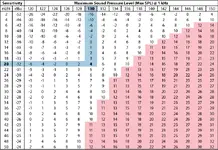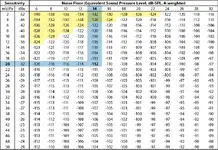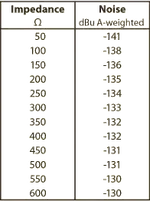. My own experience (which is admittedly a bit limited on this specific point) is that it depends upon the both the mic and the preamp as to just how little or how much the variable impedance will change the sound; there's no real predicting the result with any given combination.
I can't agree with you because there is a way and I'll try to keep it short

Here's the 2 step, the charts are below.
Step One: Evaluating Input Overload Compatibility
1.Locate the microphone Sensitivity rating on the mic data sheet.
2.Find the Maximum SPL from the mic data sheet.
3.Using Table 1, find the microphone Sensitivity rating down the left side.
4.Find the Maximum SPL rating along the top of Table 1.
5.Move right along the Sensitivity rating row and move down the Max SPL rating column until they intersect and note the number -- this is the microphone's maximum output level expressed in dBu.
6.From the microphone preamplifier's data sheet find the Maximum Input Level (in dBu).
7.Compare the mic's maximum output level obtained from Table 1 against the preamp's maximum input level obtained from its data sheet to determine compatibility.
Example Using Sample Data Sheets
1.Microphone's Sensitivity rating is 20 mV/Pa.
2.Microphone's Maximum SPL rating is 130 dB.
3.Table 1 shows the Sensitivity row marked 20 mV/Pa shaded.
4.Table 1 shows the Maximum SPL column for 130 dB shaded.
5.The intersecting point is at 4 dBu -- this is the maximum output level of the example microphone.
6.The MS 1S Mic Stage data sheet(from a Rane MS 1S Mic Stage preamplifier) lists the Maximum Input Level as +10 dBu.
7.Since this mic's max output level is +4 dBu and the preamp can handle +10 dBu, then this mic will not overload this preamp (when set for minimum gain).
Step Two: Evaluating Noise Performance
Dynamic Mics
1.Find the impedance specification on the data sheet (use "actual" instead of "rated" if given the choice).
2.Use Table 2(
look at post#15) to find the Output Noise in dBu, A-weighted, by finding the closest impedance listed.
3.Find the EIN (equivalent input noise) in dBu rating on the preamplifier's data sheet.
4.Reduce the preamp's EIN by 5 dB to approximate A-weighting.
5.Compare the two to see if the proposed preamplifier degrades the mic noise appreciably.
Condenser Mics
1.Find the Noise rating on the microphone date sheet (this is stated as Equivalent Noise Level, Self-Noise, Equivalent Noise SPL, or Noise Floor), expressed in dB SPL, A-weighted.
2.Locate the microphone's Sensitivity rating on the data sheet.
3.Using Table 3, find the microphone Sensitivity rating down the left side.
4.Find the Noise rating in dB SPL, A-weighted along the top of Table 3.
5.Move along the Sensitivity rating row and move down the Noise column until they intersect and note the number -- this is the output noise converted to dBu, A-weighted.
6.Find the EIN (equivalent input noise) in dBu rating on the preamplifier's data sheet.
7.Reduce the preamp's EIN by 5 dB to approximate A-weighting.
8.Compare the two to see if the proposed preamplifier degrades the mic noise appreciably.
Condenser Microphone Example Using Sample Data Sheets
1.Microphone's Equivalent Noise Level is 14 dB SPL, A-weighted.
2.Microphone's Sensitivity rating is 20 mV/Pa.
3.Table 3 shows the Sensitivity row marked 20 mV/Pa shaded.
4.Table 3 shows the Noise column for 14 dB SPL, A-weighted shaded.
5.The intersection point is at -112 dBu, A-weighted: this is the output noise of the microphone.
6.The MS 1S Mic Stage data sheet lists the Equivalent Input Noise as -128 dBu (no weighting).
7.Reducing this by 5 dB yields a preamp EIN of -133 dBu, A-weighted.
8.The difference between the microphone’s output noise of –112 dBu A-weighted and the preamp’s EIN of –133 dBu A-weighted is –21 dB so the preamp’s noise will not degrade the performance of the mic.
TABLES 1 & 3:



 , can you tell us how you match your microphones to preamps? When selecting a mic preamp don't you want to know to what degree the preamp's noise degrades the noise of your microphone?
, can you tell us how you match your microphones to preamps? When selecting a mic preamp don't you want to know to what degree the preamp's noise degrades the noise of your microphone?

